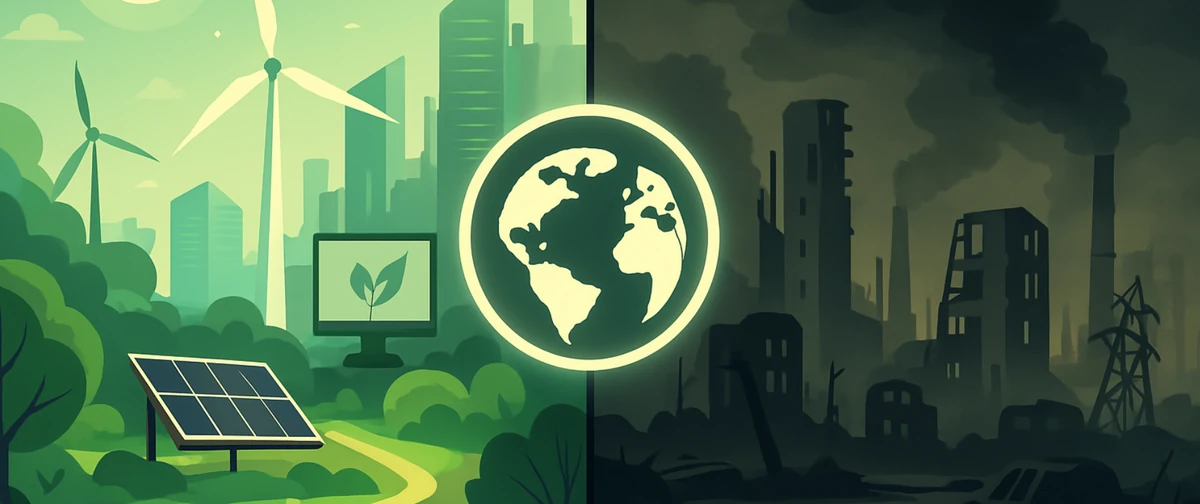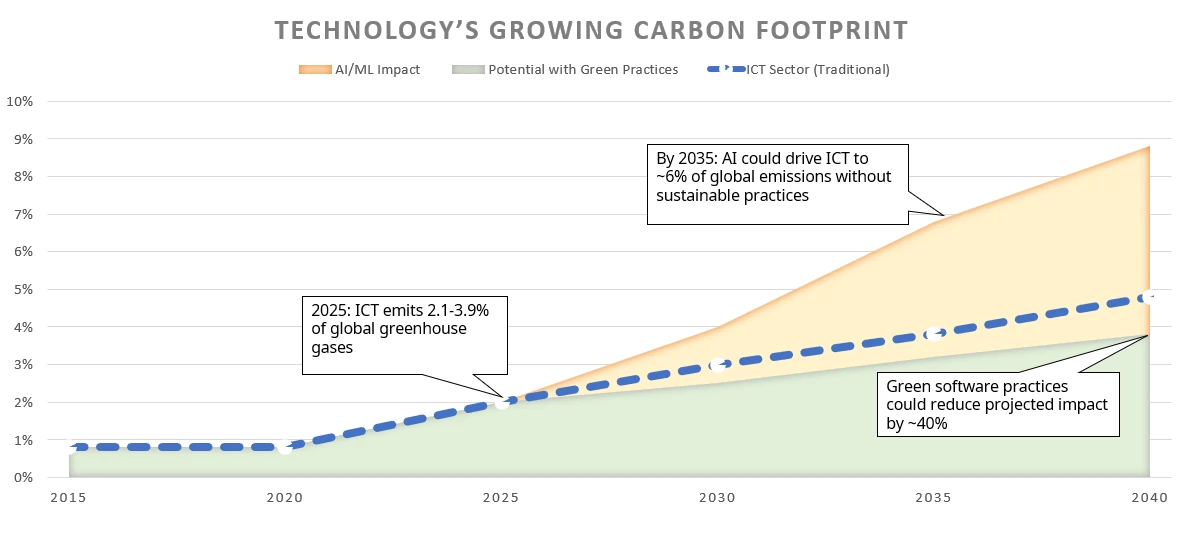Sustainable Technology: A Business Imperative
How environmentally conscious software development is becoming essential for business success and environmental impact.

The Hidden Carbon Footprint of Software
When we think about things that impact our environment, our computer software rarely comes to mind. Unlike manufacturing or transportation, code doesn’t seem to have a physical presence—but the reality tells a different story.
According to research published in the journal “Patterns”, information and communication technology (ICT) currently generates ~2.1-3.9% of global greenhouse gas emissions when accounting for full supply chain pathways–roughly equivalent to the aviation industry (ScienceDirect, 2021).
What was once a nice-to-have is rapidly becoming a business imperative. The convergence of regulatory pressure, market demands, cost considerations, and talent expectations has created a perfect storm pushing sustainable software practices into the mainstream.
Four Drivers Making Green Software Essential
1. Economic Incentives Are Aligning
Sustainable software isn’t just about environmental impact—it’s increasingly about the bottom line. Organizations implementing green software practices are reporting significant operational cost savings. Recently, Microsoft documented a 40% reduction in energy costs by optimizing cloud resources and implementing efficient coding practices and Google’s data centers now deliver 7 times more computing power with the same electrical power compared to five years ago.
In my experience leading digital transformation initiatives, we found that transitioning from physical media distribution to digital delivery not only reduced our environmental footprint but significantly cut distribution costs and accelerated our time-to-market.
2. Customer and Stakeholder Expectations Are Rising
Today’s consumers increasingly factor sustainability into their purchasing decisions. According to IBM’s 2023 Institute for Business Value study, 62% of consumers are willing to change their purchasing habits to reduce environmental impact, up from 57% in 2022.
This shift is particularly pronounced among younger demographics. Recent research from First Insight and the Baker Retailing Center at the Wharton School found that 75% of Gen Z consumers believe sustainability is more important than brand name when making purchase decisions (World Economic Forum, 2022). This generation is not only prioritizing sustainable products themselves but actively influencing older generations to adopt similar values, with Gen X consumers’ willingness to pay more for sustainable products increasing by 42% since 2019 (First Insight, 2021).
3. Regulatory Landscape Is Evolving
The regulatory environment around digital sustainability is rapidly developing. The EU’s Corporate Sustainability Reporting Directive (CSRD) now requires large companies to report on their environmental impact, including digital operations.
In the United States, California is leading with landmark climate disclosure legislation signed in 2023. This includes the Climate Corporate Data Accountability Act (SB-253), which requires companies with annual revenues over $1 billion doing business in California to disclose their greenhouse gas emissions, including technology-related emissions (KPMG, 2025). Meanwhile, the SEC has adopted new climate disclosure rules requiring public companies to publish information about climate-related risks that are “reasonably likely to have a material impact” on their business (SEC, 2024).
These regulations are creating new compliance requirements that software organizations must address—turning sustainable software from a voluntary initiative to a legal necessity in many markets.
4. Talent Attraction and Retention
Today’s technology professionals, particularly younger workers, increasingly want their work to align with their values. The 2024 Stack Overflow Developer Survey included a new section specifically asking developers about AI ethical concerns, with misinformation/disinformation and source attribution emerging as top priorities—indicating growing ethical awareness among technical professionals (Stack Overflow, 2024).
Of particular relevance to climate efforts, the survey reveals growing interest in questions about technology’s broader impacts, with developers seeking employment at organizations whose missions and practices align with their personal values.
Organizations that demonstrate commitment to sustainable practices gain an edge in the increasingly competitive talent market—particularly for in-demand roles like cloud architects, AI specialists, and security professionals.
Sustainability isn’t just the right thing to do—it’s increasingly becoming the smart thing to do from a business perspective. Software organizations that ignore this shift risk falling behind on multiple fronts: talent acquisition, operational efficiency, regulatory compliance, and market positioning.
— Greg Petro, CEO of First Insight
Green Software in Practice: Beyond the Server Room
Sustainable software practices extend far beyond energy-efficient data centers. The entire software lifecycle presents opportunities for environmental improvement.
Design and Architecture Choices
The architectural decisions made early in development can dramatically impact a software product’s environmental footprint:
- Cloud-native designs that efficiently scale resources based on actual demand rather than peak capacity
- Serverless architectures that minimize idle resource consumption
- API consolidation to reduce unnecessary data transfers and processing
Development Practices
How software is written directly impacts its efficiency:
- Optimized algorithms that accomplish tasks with fewer computational resources
- Efficient data structures that minimize memory usage
- Reduction of technical debt that leads to convoluted, inefficient code
Deployment and Operations
How software runs in production often represents the largest opportunity for sustainability improvements:
- Automated scaling to match resources with actual demand
- Workload shifting to utilize renewable-energy-powered data centers when possible
- Efficient content delivery networks to reduce data transfer distances and associated energy costs
End-of-Life and Updates
Sustainable software practices also consider what happens when software is replaced or updated:
- Graceful deprecation strategies that avoid the need for disruptive replacements
- Data archiving policies that balance retention needs with storage impacts
- Update efficiency to minimize the resources required for regular maintenance
Practical Implementation: Green Software Practices by Impact Level
Not all sustainable practices have equal impact. Here’s a prioritized approach organized by potential business and environmental benefits:
High Impact Practices
| Software Phase | Practices | Business Benefits |
|---|---|---|
| Architecture & Design | • Cloud-native architectures with auto-scaling • Serverless computing for episodic workloads • Regional deployment for renewable energy usage | • 30-50% infrastructure cost reduction • Improved scalability • Enhanced disaster recovery |
| Infrastructure | • Container optimization • Right-sizing instances • Workload scheduling during renewable energy peaks | • 20-40% reduction in cloud costs • Improved application performance • Reduced carbon intensity |
| Data Management | • Data lifecycle management • Compression and deduplication • Tiered storage strategies | • 40-60% reduction in storage costs • Faster data access • Simplified compliance |
Medium Impact Practices
| Software Phase | Practices | Business Benefits |
|---|---|---|
| Code Optimization | • Efficient algorithms • Minified and bundled assets • Lazy loading | • 10-25% better application performance • Reduced latency • Better user experience |
| Testing & QA | • Optimization testing • Performance benchmarking • Energy consumption profiling | • 15-20% reduction in production bugs • Lower maintenance costs • Improved reliability |
| DevOps | • Efficient CI/CD pipelines • Environment hibernation • Build optimization | • 30-40% reduction in development infrastructure • Faster development cycles • Consistent deployments |
Low Impact (but Still Important) Practices
| Software Phase | Practices | Business Benefits |
|---|---|---|
| User Interface | • Dark mode support • Efficient rendering • Reduced animation | • 5-10% energy saving on client devices • Improved accessibility • Brand differentiation |
| Documentation | • Efficiency best practices • Sustainability guidelines • Green metrics reporting | • Culture shift throughout organization • Enhanced developer awareness • Compliance preparation |
Note: Impact percentages are industry averages based on case studies and may vary by organization and implementation.
Measuring Success: Metrics That Matter
One of the challenges in sustainable software has been establishing consistent metrics. Several frameworks have emerged to address this gap.
- Software Carbon Intensity (SCI) – A specification from the Green Software Foundation that measures carbon emissions per software system
- Performance Efficiency Ratio – Energy consumed relative to useful work completed
- Resource Utilization – Percentage of provisioned resources actually used for productive work
- Water Usage Effectiveness (WUE) – Particularly relevant for AI applications, which have notable water footprints for cooling data centers
These metrics provide tangible ways to measure progress and identify optimization opportunities, allowing organizations to track improvement over time. Companies in California will soon need standardized measurement approaches as they prepare to comply with the Climate Corporate Data Accountability Act, which requires reporting on technology-related emissions beginning in 2026 (Harvard Law School, 2024).
Personal Insight: Three Lessons from the Field
In my experience implementing sustainable software practices across enterprise environments, three key insights stand out:
The cloud connection is powerful Green practices align naturally with cloud migration and distributed systems approaches, creating a compelling business case. Organizations can accelerate time-to-value through containerization and serverless approaches while simultaneously reducing environmental impact. This dual benefit makes sustainability initiatives easier to justify and implement. Major cloud providers are making significant commitments in this area, with Microsoft pledging to run entirely on renewable energy by 2025 (Columbia Climate School, 2023).
Start with the quick wins Begin with straightforward optimizations like eliminating zombie instances, consolidating development environments, and implementing basic resource scaling. These changes typically require minimal effort while providing immediate cost and environmental benefits that build momentum for more ambitious initiatives. In our experience, we achieved significant impact by simply transitioning from physical media distribution to digital delivery—reducing not only our carbon footprint but also cutting distribution costs and accelerating our time-to-market.
Measurement drives improvement Teams that implement consistent sustainability metrics see significantly more progress than those operating without clear benchmarks. Establishing baseline measurements and regular reporting creates accountability and highlights optimization opportunities that might otherwise go unnoticed. With California’s climate disclosure laws coming into effect and reports due in 2026, having measurement infrastructure in place now will provide competitive advantage (PwC, 2025).
The Path Forward: Building Sustainable Technical Practices
As we look ahead, several emerging practices show particular promise:
- Carbon-aware computing that shifts workloads to times and locations with greater renewable energy availability
- Energy-efficient AI that optimizes model training and inference to reduce computational requirements
- Circular hardware practices that extend device lifecycles and improve end-of-life recycling
For organizations beginning their sustainable software journey, I recommend a three-stage approach:
- Assessment: Establish baselines by measuring current energy usage and environmental impact
- Implementation: Begin with high-impact, low-effort changes while developing longer-term strategies
- Integration: Build sustainability considerations into every stage of the software development lifecycle
Conclusion: A Competitive Advantage in Waiting
Sustainable software practices represent a rare alignment of ethical, financial, and strategic imperatives. Organizations that recognize this opportunity can simultaneously reduce costs, meet regulatory requirements, attract talent, and reduce environmental impact.
The case for sustainable software goes beyond environmental altruism. It’s about building more efficient, forward-thinking organizations that are prepared for the regulatory, market, and talent landscapes of tomorrow. As California’s climate disclosure laws come into effect and similar requirements spread globally, companies with established green software practices will navigate these changes with greater ease.
Digital transformation continues to accelerate across industries, with AI and data-intensive applications multiplying the environmental footprint of technology. The organizations that address this challenge proactively will find themselves with a significant competitive advantage—both in market positioning and operational efficiency.
The question for today’s technology leaders isn’t whether to implement green software practices, but how quickly they can do so while the opportunity for differentiation remains.
What steps is your organization taking to make its software more sustainable?










Share this post
Twitter
Facebook
Reddit
LinkedIn
Pinterest
Email